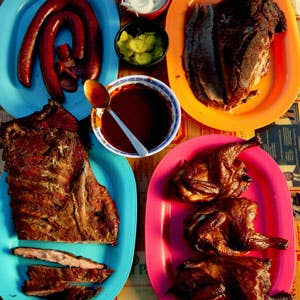
Know Your Texas Barbecue
The Lone Star State lays claim to a distinctive style of slow-cooked, smoky barbecue.
The Lone Star State's distinctive style of slow-cooked, smoky barbecue originated in the mid-19th century, primarily in meat markets owned by German and Czech immigrants in Central Texas. (A few of those establishments, including the 109-year-old Kreuz Market, in Lockhart, are still going strong today.) Texas being cattle country, beef is king, and the flavorful brisket (taken from the animal's chest, between the front legs) is by far the favorite cut. Texans separate themselves into two brisket preference camps: those who like it "fatty" (lush and loose, from muscles nearest the surface) and those who stick to "lean" (from deep muscles attached to the rib cage, which have a tight, uniform texture and less fat than a supermodel). Because a whole brisket has a fattier end and a leaner end, many places—like Snow's, in the central town of Lexington—serve both. Years ago, beef ribs the size of ax handles were a point of he-man pride among the pit masters at Texas barbecue joints; in recent years they have been muscled aside by daintier, moister pork spareribs and baby back ribs. A good sausage is hard to find. Most restaurants buy commercially made links, but some old-school spots, like Smitty's Market in Lockhart, still make their own and smoke them over wood. Chicken is also a standby; smoked whole and usually sold by the half, it can be fantastic when it's right off the smoker, mahogany hued and moist. But, like lean brisket, chicken dries out fast. Cognoscenti never buy chicken after rush hour. As for sauce, regional variations, like the vinegar-spiked pepper sauce traditional to Central Texas's German-style joints, are vanishing. Nowadays, you find the same thick, sweet-tart sauce no matter where you go.
Keep Reading
Continue to Next Story










